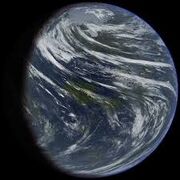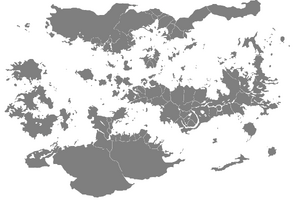
Artist's conception of what Venus might look like terraformed. Note; the clouds portrayed are assuming the planet's rotation has not been sped up.
There is a debate about whether or not Venus can be terraformed into a planet capable of hosting Earth life.
There would have to be several major, costly & time consuming climate changes:
- Reducing Venus' 850°F (773 K) surface temperature.
- Eliminating most of the planet's dense 9 MPa (~90 atm) carbon dioxide atmosphere, via removal or conversion to some other form.
- Establishing a day/night light cycle shorter than Venus' current 116.75 day solar day.
- Removing the sulfuric acid rain
These goals are closely related, since Venus' extreme temperature is due to the greenhouse effect caused by its dense atmosphere.
Solar Shades
The construction of a solar shade is impractical and thus will be overlooked in this article
Temperatures will have to be dramatically reduced by reducing the atmosphere, adding solar shades and reducing the insolation. Then the long day accounts for lacking magnetic field. Speeding the rotation until it reaches roughly 24 hours will be very important. Bombarding the planet with ice will build up the water content. Adding nitrogen into the atmosphere will dissolve 2 bars of atmosphere into the new oceans. Then the atmosphere is finally 1 bar. Plant life will create oxygen levels on Venus.
Eliminating Dense Carbon Dioxide Atmosphere
Floating Cities

a 2D map layout of what Venus's surface might look like terraformed. Unlike Earth, there is only one main continent, as well as several smaller islands surrounding it.
Geoffrey A. Landis proposes colonizing the cloud-tops of Venus. Initially, the image of floating cities may seem fanciful, but Landis' proposal points out that a Terran breathable air mixture (21:79 oxygen-nitrogen) is a lifting gas in the Venusian atmosphere, with half the lifting power helium has on Earth. In effect, a gasbag full of human-breathable air would sustain itself and extra weight (such as a colony) in midair. At an altitude of 50 km above Venusian surface, the environment is the most Earthlike in the solar system - a pressure of approximately 1 bar and temperatures in the 0°C-50°C range. Because there is not a significant pressure difference between the inside and the outside of the breathable-air balloon, any rips or tears would cause gases to diffuse at normal atmospheric mixing rates, giving time to repair any such damages. In addition, humans would not require pressurized suits when outside, merely air to breathe and a protection from the acidic rain. Without a pressurized suit, low pressure, like on Mars, would cause a person's blood to boil.

Another hypothetical political map of Venus.
Such colonies could be constructed at any rate desired, allowing a dynamic approach instead of needing any 'fell swoop' solutions. They could be used to gradually transform the Venusian atmosphere, with their impact directly related to the number of colonies in the atmosphere. As the constructed colonies increased, more solar panels could be used to absorb insulation and thus cool Venus; they could also be used to grow plant matter that would reduce the amount of carbon dioxide in the air. In the beginning, any impact on Venus would be insignificant. as the number of colonies grew, they could transform Venus more and more rapidly.
Introducing Hydrogen
Bombarding Venus with hydrogen, possibly from some outer solar system source, and reacting with carbon dioxide, could produce elemental carbon (graphite) and water by the Bosch reaction. It would take about 4×10^19 kg of hydrogen to convert the whole Venusian atmosphere. (Loss of hydrogen due to the solar wind is unlikely to be significant on the timescale of terraforming.) Due to the relatively flat Venusian surface, this water would cover about 80% of the surface compared to 70% for Earth, even though it would amount to only roughly 10% of the water found on Earth.
The remaining atmosphere, at around 3 bars (about three times that of Earth), will mainly be composed of nitrogen, some of which will dissolve into the new oceans of water, reducing atmospheric pressure further, in accordance with Henry's law.
Transformation Into Carbonates
Bombardment of Venus with refined magnesium and calcium metal could sequester carbon dioxide in the form of calcium and magnesium carbonates. About 8×10^20 kg of calcium or 5×10^20 kg of magnesium would be required, which would entail a great deal of mining and mineral refining. 8×10^20 kg is a few times the mass of the asteroid 4 Vesta (more than 300 miles in diameter).
Modelling by Mark Bullock of Venus' atmospheric evolution suggests that existing surface minerals, particularly calcium and magnesium oxides, could serve as a sink of carbon dioxide and sulphur dioxide. If these could be exposed to the atmosphere then the planet would cool and its atmospheric pressure decline somewhat. One of the possible end states modelled by Bullock was a 43 bar atmosphere and 400 K surface temperature.
Rotation
Venus rotates once every 243 days – by far the slowest rotation period of any of the major planets. A Venusian sidereal day thus lasts more than a Venusian year (243 versus 224.7 Earth days). However, the length of a solar day on Venus is significantly shorter than the sidereal day; to an observer on the surface of Venus the time from one sunrise to the next would be 116.75 days. Nevertheless, Venus's extremely slow rotation rate would result in extremely long days and nights, which could prove difficult for most known Earth species of plants and animals to adapt to. The slow rotation also likely accounts for the lack of a significant magnetic field
Speeding up rotation
It may be possible to speed up the rotation and tilt the axis more by running the planet mercury (or a galilean moon) in a close flyby and locking it in as a moon. Using Oort Cloud bodies for hydrogen seeding, with careful planning, they could also be used in close flyby to speed rotation, as suggested by recent scientific research. *
Polar Orbiting Mirror
In 1991, Paul Birch proposed that instead of trying to speed up the rotation of Venus, that if a slatted system of mirrors were placed near the Lagrangian L1 point, between Venus and the Sun, they could be used to reflect the intense sunlight, heading towards Venus, away from the planet. A soletta mirror could then, if placed in a 24-hour polar orbit, tilted at an angle to focus sunlight striking it onto Venus, be used to produce a 24-hour light cycle over the whole surface of Venus.